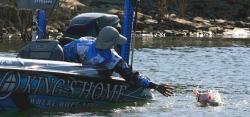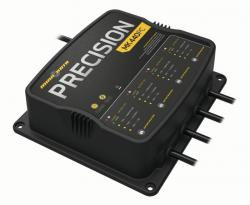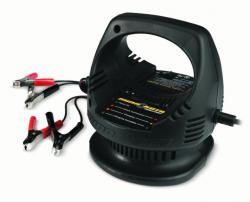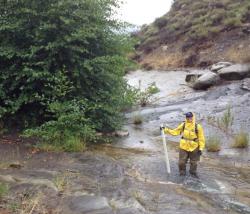Go North Or South For Georgia Bass in September
September is often a mean month for bass fishermen. Although there are hints of cooler weather and the days are getting shorter, the bass are slow to respond and start feeding consistently in shallow water. But you can catch a lot of bass, and some big ones, no matter where you live in our state.
If you live south of the Fall Line, Lake Walter F. George, usually called Lake Eufaula by fishermen, is a great place to catch September bass. It is at the top of its usual five year cycle right now, with a lot of quality three to five pound largemouth in the lake.
The Georgia Department of Natural Resources, Wildlife Division, Fisheries Department says you can expect to catch a lot of bass over the 14 inch minimum size with a good number of fish over three pounds. You also can catch some quality fish over six pounds, with the chance of a wall hanger over eight pounds.
Scott Montgomery and his father own Big Bite Bait Company near Georgetown and Scott has been fishing Eufaula all his life. Scott says bass are still in their summer pattern in September, with more migration toward more shallow water late in the month. But you can consistently catch them on two basic patterns.
When the light is low early in the morning, late in the day and on cloudy days the lily pads are a feeding area for bass. While the sun is bright some bass will still hold under the pads and be caught around them, but your better bet is get out on the many ledges where they hold and feed on bright sunny days.
The area around Cowikee Creek has all the cover and structure you can fish in several days and is one of the best areas on the lake for bass fishing. Big flats covered with pads are everywhere and the creek and river ledges in that area concentrate bass in key spots.
In both areas subtle changes can make all the difference between casting and catching. A small ditch running through the pad fields and a cut or sharp swing in the channel on the ledge are structure changes you want to find. The pads provide the cover in shallow areas but rockpiles, stumps and brush on the ledges are the type cover you want to fish.
Scott says your tackle selection is fairly simple. For the pads, have a weedless topwater bait like his company’s Top Toad or Floatin’ Toad tied on. A spinnerbait or jig and pig will also catch fish from the pads and you can fish them slowly when you find a concentration of fish.
On the ledges Scott likes a big plug like the Bomber Fat Free Shad or Norman DD22N for covering the depths quickly to locate fish. To slow down and work an area carefully switch to a Texas or Carolina rigged big worm like the ten inch Mangum Kriet Tail or Kriet Creature bait.
Since the water is clear this time of year use shad colored baits. A sexy shad or gizzard shad color in the crankbait is good and tilapia or green pumpkin with blue and purple flakes in the soft baits are good choices. And watermelon with red flakes is always a good choice for the worms.
If you put in at Lake Point State Park you don’t need to go far. The boat channel in Cowikee Creek is marked by poles leading from the launch ramp out to the river. Although these poles are not always right on the creek channel, they mark an area clear of stumps and standing timber you can run, some of them sit right on the creek ledge.
The second set of pole markers going out of the park are a well-known spot. It is well known since it holds so many bass and is a good example of the kind of channel ledge you want to fish. Just downstream of the green marker is a hump rising to about 13 feet deep at full pool. The channel makes a swing by it and there are stumps on the hump and drop into the channel.
Scott starts fishing here by sitting in the channel and casting toward the highway causeway. Try a big crankbait first then drag you soft baits along the bottom, fishing both from shallow to deep. Work all the way around the hump, bring your baits from deep to shallow, too.
You can work your way down the creek checking the ledges all the way to the river. A good depthfinder is invaluable to find the changes in the bottom and even seeing bass and baitfish. The presence of baitfish means bass will be close by and you should fish the area to find the key spot they are holding. Current makes these deeper spots a lot better as does some wind blowing across them.
When you get out to the Chattahoochee River channel it is marked by drum buoys and provides many good drops to fish. A good one that is an example of what to look for is just downstream of channel marker 100.7. Stop at it and idle downstream on top of the ledge, watching for a ditch that cuts across it. The top of the ledge is only six to eight feet deep but the ditch drops off to 18 feet deep then comes right back up and the river channel is much deeper.
When you find the ditch, start with your boat in the mouth of it and fish up the ditch, casting all your baits to both sides of it. When you hit cover like stumps or brush concentrate casts to that area. Current is very important here since it eddies across the drops and makes the bass feed.
For shallow pad fishing start at the second set of pole markers coming out of Lake Point and make a hard left if you are going downstream. Idle toward the point with cypress trees on it and lily pads all around it. Scott says this is an excellent place to find shallow fish.
Scott stops on the point and fishes toward the motel at the state park. Make long casts into the pads and fish across them, pausing when you come to holes in them. Keep your boat out from the edge of them and also pause when you get to the edge. Bass often hold right on the outside edge.
Look for other pad areas near the channel and try to find a ditch coming through them or where the form a point. There are dozens of similar spots all the way to the river to fish.
If you live in the north half of the state Lake Lanier is hard to beat for September fishing. The lake is loaded with big spotted bass and they are on predictable patterns all month.
State fisheries biologists say there is a good population of two to four pound spots in Lanier and most tournaments have a five pound plus fish weighed in. Some fishermen think there is a new world record spot swimming in Lanier and seven pound plus spots are reported fairly often.
Rob Jordan grew up fishing Lake Lanier and lives in Suwanee and fishes it several days a week. This year he won a BFL tournament on the lake with five fish weighing 19.5 pounds, and has weighed in a 21.5 pound five fish tournament limit, so he knows its spotted bass and their habits well.
“Lanier is not like other lakes since the big spots roam water 50 to 60 feet deep and you can not catch them by fishing like you do in other lakes,” Rob said. You have to fish where the big ones live, and September is a transition month on Lanier. But if you fish the right places and right baits this month you can catch some big ones, as the six pound, six ounce spot he caught in September while guiding a client last year proved.
Rob will have a drop shot and shaky head worm ready for fishing slowly this month. For catching more active bass he will fish a topwater bait and a swim bait. He is often sitting in 80 plus feet of water and casting to water 30 feet deep or deeper, so you have to fish deep for the big ones.
The main lower lake is the best area to fish, according to Rob and you can find key spots in a variety of ways. Shoal and channel markers are often near the places where big spots hold very deep and move a little shallower to feed.
A couple of good examples are near the dam. In the mouth of Shoal Creek green channel marker 3SC sits on the end of a long rocky hump right by the channel. There is a danger marker on top of the hump so it comes up very shallow but water 100 feet deep is not far away. Every point and hump in Lanier has brush on it fishermen put out, and the bass hold in it and roam out to feed so locating brush piles is important.
This hump is very rocky, something spots love, and there is brush all over it at different depths. Rob likes to start with his boat out in very deep water and cast a topwater plug like a big Zara Spook to the shallows around the hump and work it back fast. This will often draw a suspended spot up to feed. Also throw a big swim bait to cover the top and sides of hump.
For bragging size spots Rob likes a Bull Shad swimbait. He custom paints them, a skill he learned from his cousin Professional bass fisherman Jim Murray, Jr. Jim also taught him a lot about fishing for bass. His colors that resemble blue back herring work well since that is the baitfish big spots eat. Fish the swimbait at different speeds and depths to find what the big spots want.
Move your boat to more shallow water, around 35 feet deep, and watch your depthfinder for brush. When you see it use a drop shot worm to fish beside and in it. While you are looking for brush cast a shaky head worm to ten feet of water and work it back to 30 feet deep for spots feeding on the rocks.
Rob likes soft like a ZMan Finesse worm on his drop shot or jig head. Any watermelon color with flakes in it can be good, as are colors like morning dawn. If the fish want something bigger he will offer them a Big Bites Bait six inch Finesse worm in the same colors.
Another good place is the hump just off channel marker 1YD in Young Deer Creek marked with a danger marker. It also has rocks and brush with deep water nearby to hold magnum spots. Fish it the same way. Some wind blowing across these places makes them even better.
Always watch for surface activity. September is a good month to catch schooling spots. If you see swirling fish near you cast a topwater plug or swim bait to them. If you see splashes in the distance, or gulls diving, run to them, stop a long cast away from the activity, and catch the fish as they chase shad or herring.
There are dozens of similar places all over the lower lake to fish, and they are easy to find since channel markers near shoal markers point them out. Pleasure boat traffic gets extremely bad on Lanier, even in September, so weekdays or weekends before 10:00 AM are the best time to fish.
Whether you live north or south in Georgia these lakes are close enough for a one day trip. Or if you variety, head to the other part of the state from where you live to experience a very different kind of fishing. Decide which you like best.







